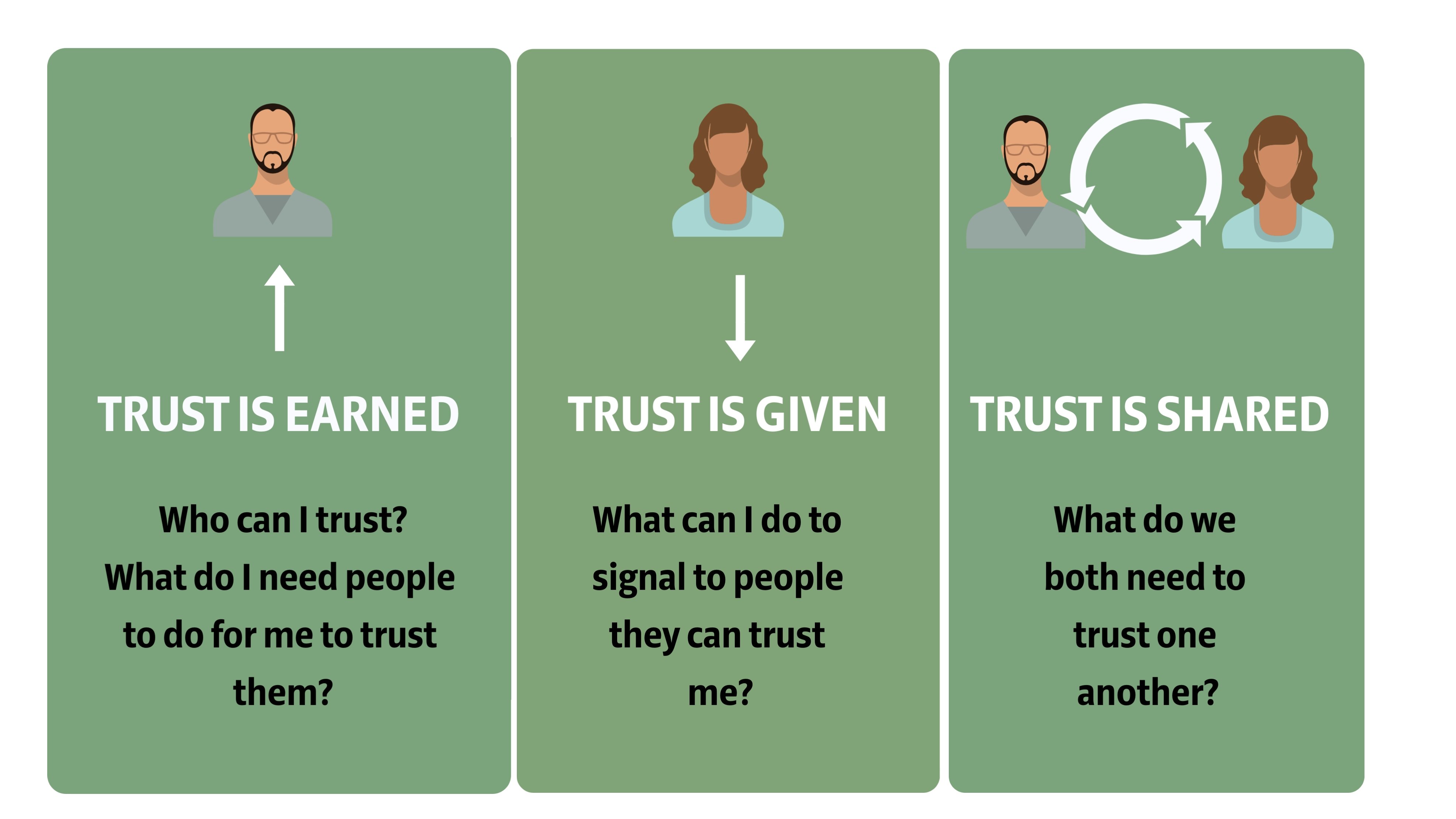
How do you make the decision to trust others?
That's the question that Jim Collins asked his mentor some years ago. Collins is a student and teacher of what makes great...
Have you ever started a new job or worked with a new team and realised that you needed to build trust quickly?
Building trust and managing it long term, is one of the number one skills of a high performing leader. This is critical during uncertainty because if changes aren’t managed well, people will stop trusting leadership.
Every leader knows that trust is important. The problem is that being good at fostering trust is hard. Trust is situational, dynamic, emotional and multi-directional. Not only that each person around you varies in their propensity to trust based on their tolerance to risk, personality characteristics, life experiences and level of power.
For many leaders, managing trust in teams is a challenge because there are three different forces at play. It’s important to understand these main dynamisms so that we can mitigate the damage they can potentially cause when mismanaged.
Let's take a look at 3 Supporting and Opposing Trust Forces Model taken from the book, Trusted to Thrive: How leaders create connected and accountable teams.
.jpg?width=3947&name=3-Types-of-Forces-that-Impact-Trust%20(2).jpg)
Macro forces tend to be either external to the organisation or part of the internal fabric of how work is done overall in an organisation’s architecture.
Savvy leaders understand that their team members crave certainty and look to them for reassurance. Macro forces can easily undo the good work you have done ensuring your team feel unsure about what is going on. It makes it hard to manage the tension between being transparent and predicting the future with meeting leadership obligations.
Macro forces can include external volatility such as pandemics, changes in Government regulations, new competitors or game-changing technologies. Internal changes include new CEO’s, restructures, mergers and acquisitions, new team members and product shifts.
Furthermore, corporate bureaucracy, communication and uncollaborative leaders can often make it appear the organisation doesn't care about employees. It becomes a challenge for leaders who are tasked with inspiring their team to commit to the company vision when corporate information and top leaders demonstrates a lack of caring for people.
Unfortunately, this is where many well-meaning leaders become frustrated with corporate bureaucracy that appears to unintentionally work against them.
As one leader from an engineering company said “I spend 10% of my time on admin and 15% buffering my team from organisation, so they can do their job. They’re aware I do that because they hear from other teams about how difficult things are. I get accolades because they know I filter and buffer and make work more enjoyable."
Then, there are trust issues that occur more within the team domain that team leaders have more control over, but still need to navigate:
This requires taking the time to not only build trust with each team member, but encouraging each person to understand one another. In particular, the contribution and role of each person in the team.
But one of the biggest issues that impact team trust is how the team leaders managers poor performance and fairness levels.
Research by University of California Professors Naomi Eisenberger and Matthew Lieberman, and Purdue University Professor Kipling D. Williams found that few managers want to cause their direct reports pain, potentially risking an emotional outburst, loss of commitment, or even retaliation. Instead, in the leader’s quest to avoid messy situations and jeopardise a “nice” culture, they take the professional high road – dismissing, delaying or denying, rather than talking truthfully about what isn’t working and needs to change.
Is it costly? Of course! According to “Stop spending, Start managing” by Tania Menon and Leigh Thompson, failure to give underperforming employees feedback costs organisations US$7,600 a day.
If there is one thing that causes distrust in a team, it’s when a poor performing employee is allowed to continue working, even though their performance is dragging everyone down around them. This also includes toxic behaviours and actions. Often, the team leader becomes the source of distrust because they haven’t done anything to remove the offender. Not only that, it gives license to others to perform or behave below standard.
Then, there is always the difficult balance between allowing people privileges such as allowing a direct report to leave early, which can sometimes reduce perceived fairness levels in a team. Again, this is another area where a team leader can receive complaints if other employees don’t receive the same rewards. It creates distrust and a lack of confidence in leadership because it reeks of a failure to confront issues and a protection of the status quo.
As difficult as it is for many leaders to have candid performance conversations, trust in their team will always remain below par, until performance and inequity have been acknowledged and dealt with.
Of course, the other factor that impacts trust issues in a team revolve around the leader and their own intrapersonal skills. This means the ability to self manage, adapt to changing circumstances and learn new things. It is underpinned by self-awareness and trusting not only ourselves, but also a benevolent life source.
Tash Eurich, in her book, Insight, discovered that self-aware people have two types of knowledge – internal and external self-awareness. Internal self-awareness is knowing who we are, what makes us tick and our patterns of behaviour over time. While external self-awareness is about understanding how other people see us.
In general, human beings aren’t very self-aware. But – they think they are. Eurich found that even though most people believe they are self-aware, only 10-15% of the people she studied actually fit the criteria. It can impact whether people trust us or or even how we trust others.
For technically proficient leaders, trusting others to get work done can be one of their biggest career challenges. This is particularly tricky for lawyers, engineers and software developers who need work done at a certain level, in order to meet customer expectations.
Yet, the benefits of extending trust to others ensures that trust is reciprocated. It makes it faster to get work done as you don't have to worry or micromanage. It just takes time and patience - to communicate expectations and for the other person to get to speed.
And then there is the need to trust the little voice in our head that warns us when we need to spend more time building trust with those around us or improve our job competency.
Our ability to trust our inner voice is critical to improving our results and building relationships. Leaders who fail to listen to their ‘inner ding’, often miss out on important opportunities to improve their effectiveness.
The most important person we can trust is our self. When we make a mistake, receive harsh criticism, or miss a goal, it can be too easy to lose trust and confidence in our selves. This is detrimental to our leadership capability as our decision-making abilities falter when we fear that we will make the wrong choice.
When we don’t trust ourselves to lead or don’t think we’re worthy of being a leader, other people feel that and automatically don’t trust us. They feel something is wrong with the energy we project. While they might feel our power or capabilities, they will be confused as to why we don’t own that.
Being a successful leader means learning to trust our selves first and overcoming the highly common imposter syndrome.
Leaders that don’t trust themselves tend to not trust others and the situation. At a deeper level, how we trust others is a reflection of ourselves and our own fears and insecurities. If we don’t trust ourselves, it means we operate from fear rather than from a positive and expansive outlook. We self-protect, rather than work for the interests of our people.
At some level, it requires trusting that everything is going to work out; that we are being looked after by a benevolent force. And trust me, that can be one of the hardest things for a human being to accomplish. But the result is being calm and clear during adversity.
Ultimately, we have little control of what will transpire. Things change so fast. If there is one gift from COVID is that we have learnt to be resilient and expect things to change rapidly. Leaders who have communicated what they know and made it clear that things will still change, help employees when things turn out differently than expected.
All we can do as leaders is clearly communicate the information we have at the current time, even if it's not everything. Communication is all about reducing uncertainty and ambiguity. And employees appreciate knowing anything, rather than nothing at all.
But the more we can trust - ourselves, each other and the big vision, the more we can navigate the challenges ahead.

How do you make the decision to trust others?
That's the question that Jim Collins asked his mentor some years ago. Collins is a student and teacher of what makes great...

In today’s pressure-cooker of a business world, the ability to handle constant change is the difference between success and failure. When situations are uncertain and...